Surface Roughness-Induced Changes in Important Physical Features of CoFeSm Thin Films on Glass Substrates during Annealing
Abstract
:1. Introduction
2. Materials and Methods
3. Results
3.1. X-ray Diffraction Pattern
3.2. Electrical Property
3.3. Hardness and Young’s Modulus
3.4. Magnetic Property
3.5. Analysis of Contact Angle and Surface Energy
3.6. Optical Experiment Results and Analysis
3.7. Surface Magnetic Domains of the Thin Film
3.8. Surface Roughness and 3D Surface Topography Images of the Thin Film
4. Conclusions
Author Contributions
Funding
Institutional Review Board Statement
Informed Consent Statement
Data Availability Statement
Conflicts of Interest
References
- Skomski, R.; Coey, J.M.D. Magnetic anisotropy-how much is enough for a permanent magnet. Scr. Mater. 2016, 112, 3–8. [Google Scholar] [CrossRef]
- Cui, J.; Kramer, M.; Zhou, L.; Liu, F.; Gabay, A.; Hadjipanayis, G.; Balasubramanian, B.; Sellmyer, D. Current progress and future challenges in rare-earth-free permanent magnets. Acta Mater. 2018, 158, 118–137. [Google Scholar] [CrossRef]
- Rachid, F.Z.; Omari, L.H.; Yamkane, Z.; Lassri, H.; Derkaoui, S.; Nouri, K.; Bouzidi, W.; Bessais, L. Annealing effect on structural, microstructural and magnetic properties of nanocrystalline Er-Co-B alloys for permanent magnet applications. Mater. Chem. Phys. 2019, 228, 60–65. [Google Scholar] [CrossRef]
- Zhang, W.Y.; Zhang, X.D.; Yang, Y.C.; Shen, B.G. Effect of Cu substitution on structure and magnetic properties of anisotropic SmCo ribbons. J. Alloys Compd. 2003, 353, 274–277. [Google Scholar] [CrossRef]
- Popov, A.G.; Golovnia, O.A.; Protasov, A.V.; Gaviko, V.S.; Kolodkin, D.A.; Gopalan, R. Coercivity kinetics upon step annealing of sintered Sm(Co0.88−xFexCu0.09Zr0.03)7 magnets. J. Rare Earths 2019, 37, 1059–1065. [Google Scholar] [CrossRef]
- Suresh, K.; Gopalan, R.; Rao, D.V.S.; Singh, A.K.; Bhikshamaiah, G.; Muraleedharan, K.; Chandrasekaran, V. Microstructure and coercivity variation in melt-spun Sm–Co–Fe–Zr ribbons. Intermetallics 2010, 18, 2244–2249. [Google Scholar] [CrossRef]
- Gopalan, R.; Ping, D.H.; Hono, K.; Huang, M.Q.; Smith, B.R.; Chen, Z.; Ma, B.M. Microstructure and magnetic properties of melt-spun Sm(Co0.58Fe0.31Cu0.04Zr0.05B0.02)z ribbons. J. Appl. Phys. 2004, 95, 4962–4967. [Google Scholar] [CrossRef]
- Hua, Y.X.; Lou, L.; Jiang, B.; Kou, J.Y.; Wang, J.Y.; Li, T.C.; Gao, J.Q.; Zhang, Q.; Li, X.H. Effect of Co Content on Microstructures and Magnetic Properties of Anisotropic Bulk TbCu7-type Sm-Co Nanocrystalline Magnets. IEEE Trans. Magn. 2019, 56, 1–4. [Google Scholar] [CrossRef]
- Coïsson, M.; Celegato, F.; Tiberto, P.; Vinai, F. Magnetic properties of field annealed FeCo thin films. J. Magn. Magn. Mater. 2008, 320, e739–e742. [Google Scholar] [CrossRef]
- Kumara, A.; Srivastava, N.; Srivastava, P.C. Effect of interfacial modifications on magnetic, morphological and transport properties of CoFe/n-Si thin film structures using ion irradiation. Nucl. Instrum. Methods Phys. Res. B 2019, 451, 79–88. [Google Scholar] [CrossRef]
- Wei, L.; Zhang, Y.W.; Gong, Y.S.; Hong, Y.; Qiu, Z.G.; Zhao, L.Z.; Liu, X.L.; Zhang, X.F.; Chen, D.Y.; Zheng, Z.G.; et al. Effects of temperature gradients on magnetic anisotropy of SmCo based films. J. Alloys Compd. 2022, 898, 12900. [Google Scholar] [CrossRef]
- Liu, Y.; Yu, T.; Zhu, Z.; Zhong, H.; Khamis, K.M.; Zhu, K. High thermal stability in W/MgO/CoFeB/W/CoFeB/W stacks via ultrathin W insertion with perpendicular magnetic anisotropy. J. Magn. Magn. Mater. 2016, 410, 123–127. [Google Scholar] [CrossRef]
- Golovnia, O.A.; Popov, A.G.; Mushnikov, N.V.; Protasov, A.V.; Pradeep, K.G.; Ogurtsov, A.V.; Taranov, D.V.; Tishin, A.M. Hard magnetic properties and the features of nanostructure of high-temperature Sm-Co-Fe-Cu-Zr magnet with abnormal temperature dependence of coercivity. Nanomaterials 2023, 13, 1899. [Google Scholar] [CrossRef]
- Wong, Y.H.; Cheong, K.Y. Effects of oxidation and nitridation temperatures on electrical properties of sputtered Zr thin film based on Si in N2O ambient. Electron. Mater. Lett. 2012, 8, 47–51. [Google Scholar] [CrossRef]
- Scheike, T.; Wen, Z.; Sukegawa, H.; Mitani, S. 631% room temperature tunnel magnetoresistance with large oscillation effect in CoFe/MgO/CoFe(001) junctions. Appl. Phys. Lett. 2023, 122, 112404. [Google Scholar] [CrossRef]
- Chen, W.; Hao, R.; Lu, S.; Cao, Z.; Yan, S.; Yan, S.; Zhu, D.; Leng, Q. Influence of seed layer on the magnetoresistance properties in IrMn-based magnetic tunnel junctions. J. Magn. Magn. Mater. 2022, 546, 168674. [Google Scholar] [CrossRef]
- Pei, Y.; Yuan, M.; Wei, E.; Teng, B. Effects of Sm element addition on the workability and microstructure evolution of Mg-Gd-Y-Zr alloy during hot deformation. Mater. Des. 2023, 230, 111962. [Google Scholar] [CrossRef]
- Zhang, Q.; Cui, B.; Sun, B.; Zhang, X.; Dong, Z.; Liu, Q.; Cui, T. Effect of Sm doping on the microstructure, mechanical properties and shape memory effect of Cu-13.0Al-4.0Ni Alloy. Materials 2021, 14, 4007. [Google Scholar] [CrossRef]
- Qiao, G.; Hu, Q.; Zhang, P.; Yang, W.; Liu, Z.; Liu, S.; Wang, C.; Yang, J. The effect of samarium substitution on magnetic properties and microwave absorption of the rare earth-iron-boron compounds and composites. J. Alloys Compds. 2020, 825, 154179. [Google Scholar] [CrossRef]
- Gadkari, A.B.; Shinde, T.J.; Vasambekar, P.N. Magnetic properties of rare earth ion (Sm 3+) added nanocrystalline Mg–Cd ferrites, prepared by oxalate co-precipitation method. J. Magn. Magn. Mater. 2010, 322, 3823–3827. [Google Scholar] [CrossRef]
- Lou, C.; Kou, Y.; Lyu, X.; Zhang, W. Electrodeposition of Sm-Fe thin film in aqueous solution under a high magnetic field. Int. J. Electrochem. Sci. 2015, 10, 9687–9694. [Google Scholar] [CrossRef]
- Sato, N.; Habu, K.; Oyama, T. Magneto-optical recording on amorphous rare earth-transition metal thin films with an artificially layered structure. IEEE Trans. Magn. 1987, 23, 2314–2316. [Google Scholar] [CrossRef]
- Chouhan, R.K.; Pathak, A.K.; Paudyal, D. Understanding the origin of magneto-crystalline anisotropy in pure and Fe/Si substituted SmCo5. J. Magn. Magn. Mater. 2021, 522, 167549. [Google Scholar] [CrossRef]
- Sayama, J.; Mizutani, K.; Asahi, T.; Ariake, J.; Ouchi, K.; Matsunuma, S.; Osaka, T. Magnetic properties and microstructure of SmCo5 thin film with perpendicular magnetic anisotropy. J. Magn. Magn. Mater. 2005, 287, 239–244. [Google Scholar] [CrossRef]
- Arif, M.; Zhang, X.; Amir, M.; Liu, E.; Xu, F. Tailoring the magnetism and spin dynamics in CoFeB thin films by post annealing for spintronics applications. J. Mater. Sci. Mater. Electron. 2023, 34, 574. [Google Scholar] [CrossRef]
- Grassi, M.; Geilen, M.; Louis, D.; Mohseni, M.; Brächer, T.; Hehn, M.; Stoeffler, D.; Bailleul, M.; Pirro, P.; Henry, Y. Slow-wave-based nanomagnonic diode. Phys. Rev. Appl. 2020, 14, 024047. [Google Scholar] [CrossRef]
- Meng, H.; Lum, W.H.; Sbiaa, R.; Lua, S.Y.H.; Tan, H.K. Annealing effects on CoFeB-MgO magnetic tunnel junctions with perpendicular anisotropy. J. Appl. Phys. 2011, 110, 033904. [Google Scholar] [CrossRef]
- Vértesy, G.; Gasparics, A.; Griffin, J.M.; Mathew, J.; Fitzpatrick, M.E.; Uytdenhouwen, I. Analysis of surface roughness influence in non-destructive magnetic measurements applied to reactor pressure vessel steels. Appl. Sci. 2020, 10, 8938. [Google Scholar] [CrossRef]
- Favieres, C.; Vergara, J.; Madurga, V. Surface roughness influence on Néel-, crosstie, and bloch-type charged zigzag magnetic domain walls in nanostructured Fe films. Materials 2020, 13, 4249. [Google Scholar] [CrossRef] [PubMed]
- Kozlovskiy, A.; Zdorovets, M.; Kenzhina, I.; Berguzinov, A.; Tishkevich, D.; Zubar, T.; Trukhanov, A. The study of the applicability of ionizing radiation to increase the photocatalytic activity of TiO2 thin flms. J. Nanostruct. Chem. 2020, 10, 331–346. [Google Scholar] [CrossRef]
- Gevorgyan, V.A.; Mangasaryan, N.R.; Gremenok, V.F.; Tivanov, M.S.; Thakur, P.; Thakur, A.; Trukhanov, S.V.; Zubar, T.I.; Sayyed, M.I.; Tishkevich, D.I.; et al. Morphology and structure of CdCl2-Containing CdTe films deposited by discrete vacuum thermal evaporation. Vacuum 2023, 214, 112248. [Google Scholar] [CrossRef]
- Ma, K.; Chung, T.S.; Good, R.J. Surface energy of thermotropic liquid crystalline polyesters and polyesteramide. J. Polym. Sci. 1998, 36, 2327–2337. [Google Scholar] [CrossRef]
- Owens, D.K.; Wendt, R.C. Estimation of the surface free energy of polymers. J. Appl. Polym. Sci. 1969, 13, 1741–1747. [Google Scholar] [CrossRef]
- Kaelble, D.H.; Uy, K.C. A Reinterpretation of organic liquid-polytetrafluoroethylene surface interactions. J. Adhens. 1970, 2, 50–60. [Google Scholar] [CrossRef]
- Kube, S.A.; Xing, W.; Kalidindi, A.; Sohn, S.; Datye, A.; Amram, D.; Schuh, C.A.; Schroer, J. Combinatorial study of thermal stability in ternary nanocrystalline alloys. Acta Mater. 2020, 188, 40–48. [Google Scholar] [CrossRef]
- Peng, H.R.; Huang, L.K.; Liu, F. A thermo-kinetic correlation for grain growth in nanocrystalline alloys. Mater. Lett. 2018, 219, 276–279. [Google Scholar] [CrossRef]
- Xi, L.; Du, J.H.; Zhou, J.J.; Ma, J.H.; Li, X.Y.; Wang, Z.; Zuo, Y.L.; Xue, D.S. Soft magnetic property and magnetization reversal mechanism of Sm doped FeCo thin film for high-frequency application. Thin Solid Films 2012, 520, 5421–5425. [Google Scholar] [CrossRef]
- Vasiliev, M.; Alam, M.N.E.; Alameh, K.; Premchander, P.; Lee, Y.T.; Kotov, V.A.; Lee, Y.P. Annealing behaviour and crystal structure of RF-sputtered Bi-substituted dysprosium iron-garnet films having excess co-sputtered Bi-oxide content. J. Phys. D Appl. Phys. 2011, 44, 075002. [Google Scholar] [CrossRef]
- Kandpal, K.; Gupta, N. Study of structural and electrical properties of ZnO thin film for Thin Film Transistor (TFT) applications. J. Mater. Sci. Mater. Electron. 2017, 28, 16013–16020. [Google Scholar] [CrossRef]
- Yao, J.K.; Ye, F.; Fan, P. Temperature-dependent optical and electrical properties of InGaZnON thin films. Opt. Mater. Express 2019, 9, 3781–3788. [Google Scholar] [CrossRef]
- Zhong, W.; Li, G.; Lan, L.; Li, B.; Chen, R. Effects of annealing temperature on properties of InSnZnO thin film transistors prepared by Co-sputtering. RSC Adv. 2018, 8, 34817–34822. [Google Scholar] [CrossRef] [PubMed]
- Lopes, C.; Gonçalves, C.; Borges, J.; Polcar, T.; Rodrigues, M.S.; Barradas, N.P.; Alves, E.; Bourhis, E.L.; Couto, F.M.; Macedo, F.; et al. Evolution of the functional properties of titanium–silver thin films for biomedical applications: Influence of in-vacuum annealing. Surf. Coat. Technol. 2015, 261, 262–271. [Google Scholar] [CrossRef]
- Guo, F.; Martyniuk, M.; Silva, D.; Liu, Y.; Brookshire, K.; Faraone, L. Effect of thermal annealing on stress relaxation and crystallisation of ion beam sputtered amorphous Si1−xGex thin films. Mater. Des. 2018, 156, 389–397. [Google Scholar] [CrossRef]
- Long, Q.; Wang, L.; Yu, W.; Huang, W.; Wang, L. Structural and mechanical properties of amorphous Si–C-based thin films deposited by pulsed magnetron sputtering under different sputtering powers. Vacuum 2021, 119, 110319. [Google Scholar] [CrossRef]
- Zhang, W.; Li, J.; Xing, Y.; Nie, X.; Lang, F.; Yang, S.; Hou, X.; Zhao, C. Experimental study on the thickness-dependent hardness of SiO2 thin films using nanoindentation. Coatings 2021, 11, 23. [Google Scholar] [CrossRef]
- Jarząbek, D.M.; Milczarek, M.; Nosewicz, S.; Bazarnik, P.; Schift, H. Size effects of hardness and strain rate sensitivity in amorphous silicon measured by nanoindentation. Metall. Mater. Trans. A Phys. 2020, 51, 1620–2633. [Google Scholar] [CrossRef]
- Lovre, Ž.R.; Mongstad, T.T.; Karazhanov, S.; You, C.C.; Lindberg, S.; Lelis, M.; Milcius, D.; Deledda, S. Annealing-induced structural rearrangement and optical band gap change in Mg–Ni–H thin films. Mater. Res. Express 2017, 4, 016405. [Google Scholar] [CrossRef]
- Zhao, Y.; Gamache, R.; Wang, G.C.; Lu, T.M.; Palasantzas, G.; De Hosson, J.T.M. Effect of surface roughness on magnetic domain wall thickness, domain size, and coercivity. J. Appl. Phys. 2001, 89, 1325–1330. [Google Scholar] [CrossRef]
- Bera, A.K.R.; Gupta, P.; Garai, D.; Gupta, A.; Kumar, D. Effect of surface morphology on magnetization dynamics of cobalt ultrathin films: An in-situ investigation. Appl. Surf. Sci. Adv. 2021, 6, 100124. [Google Scholar] [CrossRef]
- Sousa, W.J.; Guerra, Y.; Garcia, P.; Hernández, E.P. Saturation magnetization as a function of temperature in Zn doped YIG nanoparticles. Phys. E Low-Dimens. Syst. Nanostruct. 2022, 138, 115054. [Google Scholar] [CrossRef]
- Wang, K.; Xu, Z.; Huang, Y.; Qiu, Y.; Dong, S. Magnetic, thermal, electrical properties and crystallization kinetics of Co60Fe20B20 alloy films. Sci. China Mater. 2016, 59, 639–647. [Google Scholar] [CrossRef]
- Yang, P.; Li, L.; Yu, S.; Zheng, H.; Peng, W. The annealing temperature and films thickness effect on the surface morphology, preferential orientation and dielectric property of NiO films. Appl. Surf. Sci. 2019, 493, 396–403. [Google Scholar] [CrossRef]
- Güzelçimen, F.; Tanören, B.; Çetinkaya, Ç.; Kaya, M.D.; Efkere, H.İ.; Özen, Y.; Bingöl, D.; Sirkeci, M.; Kınacı, B.; Ünlü, M.B.; et al. The effect of thickness on surface structure of rf sputtered TiO2 thin films by XPS, SEM/EDS, AFM and SAM. Vacuum 2020, 182, 109766. [Google Scholar] [CrossRef]
- Kalinovich, D.F.; Kovenskii, I.I.; Smolin, M.D. High-temperature mobility of atoms of the components in the system molybdenum-tungsten. Powder Metall. Met. Ceram. 1966, 5, 889–892. [Google Scholar]
- Nordlund, K.; Averback, R.S. Role of self-Interstitial atoms on the high temperature properties of metals. Phys. Rev. Lett. 1998, 80, 4201–4204. [Google Scholar] [CrossRef]
- Fan, H.; Li, Z.; Huang, M.; Zhang, X. Thickness effects in polycrystalline thin films: Surface constraint versus interior constraint. Int. J. Solids Struct. 2011, 48, 1754–1766. [Google Scholar] [CrossRef]
- Pan, P.; Debiossac, M.; Roncin, P. Temperature dependence in fast-atom diffraction at surfaces. Phys. Chem. Chem. Phys. 2022, 24, 12319–12328. [Google Scholar] [CrossRef]
- Wang, S.G.; Zhang, Q.; Yoon, S.F.; Ahn, J.; Wang, Q.; Yang, D.J.; Zhou, Q.; Yue, N.N. Optical properties of nano-crystalline diamond films deposited by MPECVD. Opt. Mater. 2003, 24, 509–514. [Google Scholar] [CrossRef]
- Pandey, M.K.; Kar, A.K. Effect of annealing temperature on the magnetic domain structure and surface mechanical properties of Ni-C composite thin films: Magnetic and lateral force microscopy, and force-distance spectroscopy. Mater. Lett. 2021, 301, 130295. [Google Scholar] [CrossRef]
- Adi, H.M.; Saadouni, K.; Badawi, M.; Mazroui, M.; Lebègue, S. Growth and annealing effect on the Cu thin film deposited on Si (0 0 1) surface. J. Cryst. Growth 2022, 586, 126631. [Google Scholar]
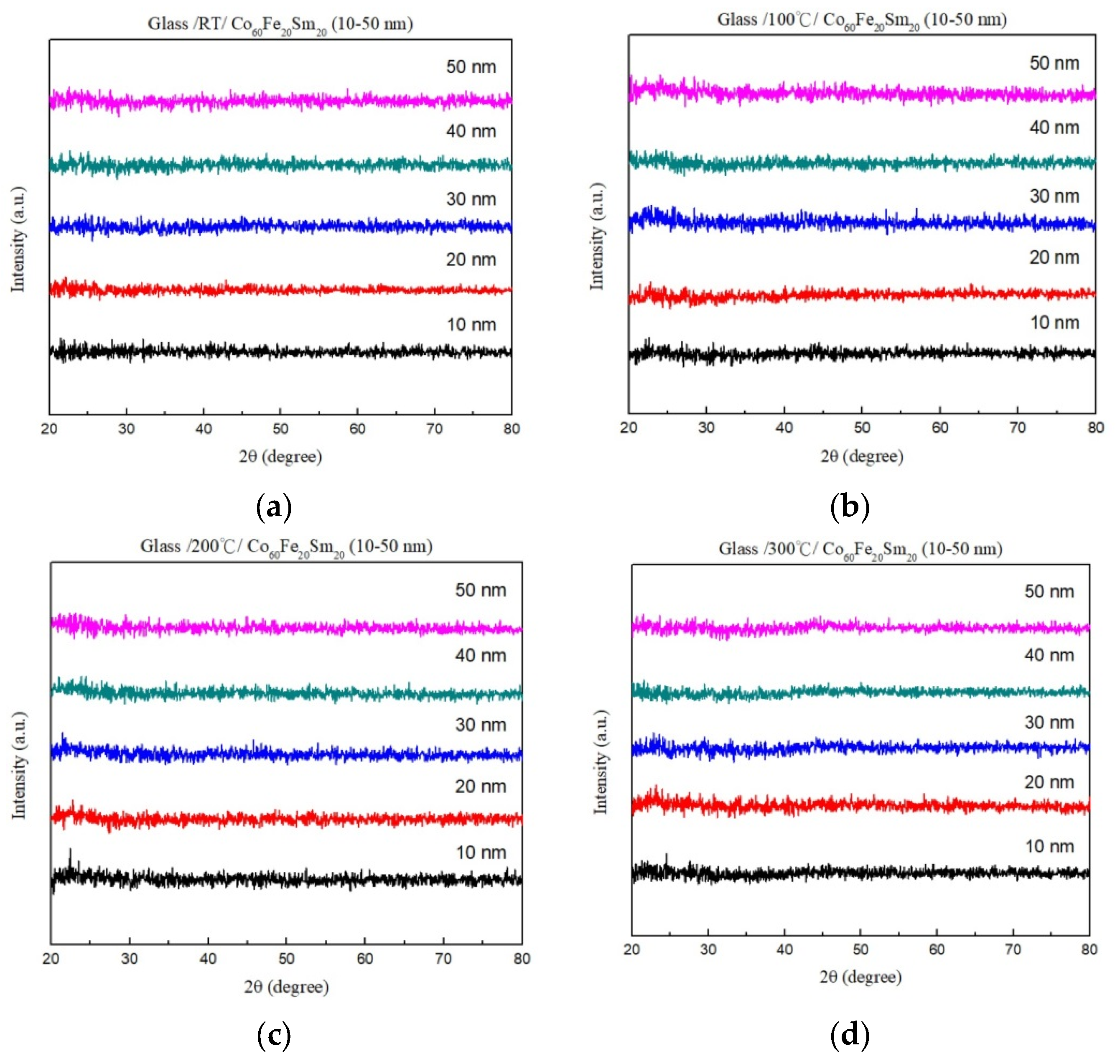
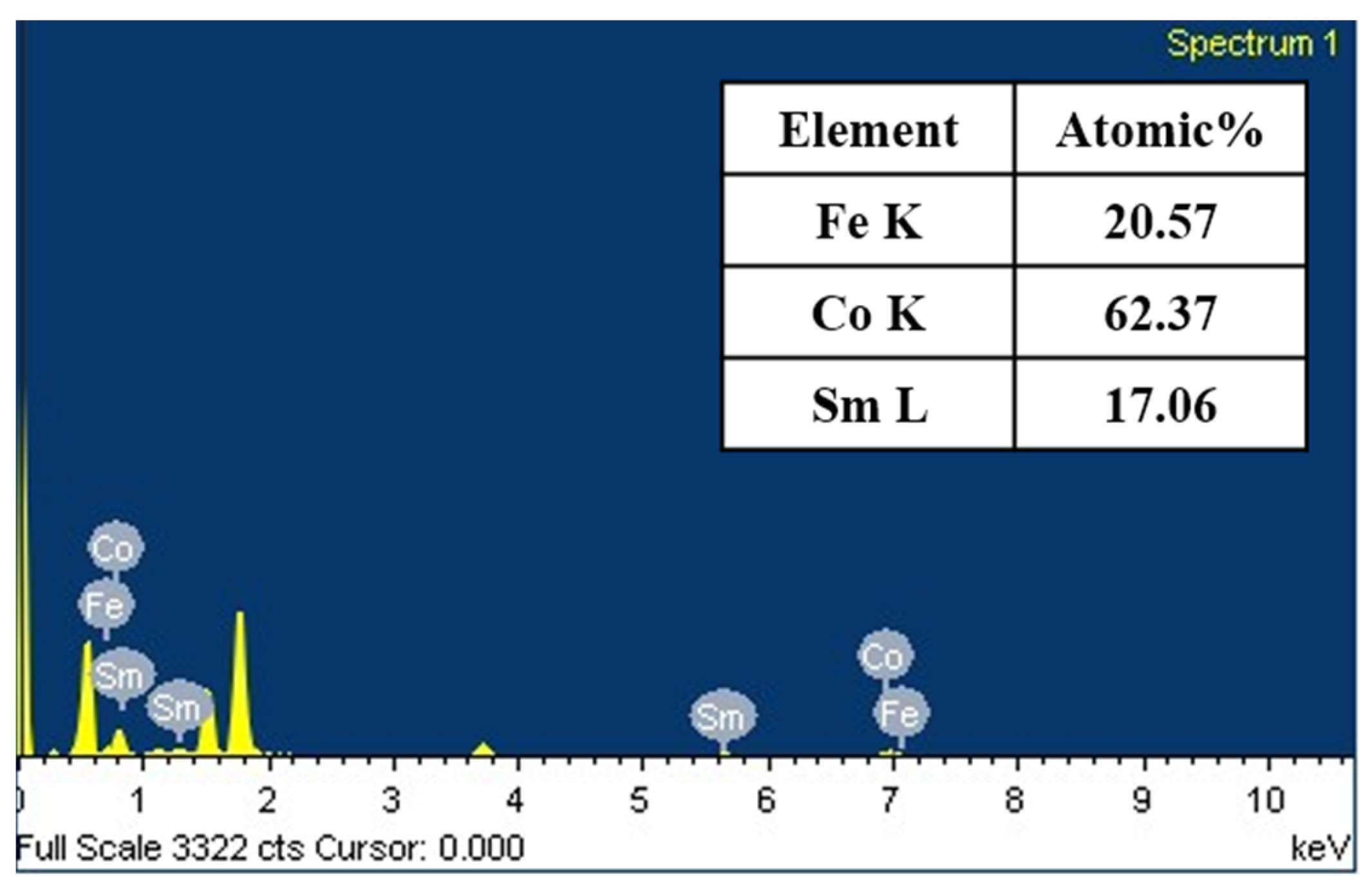
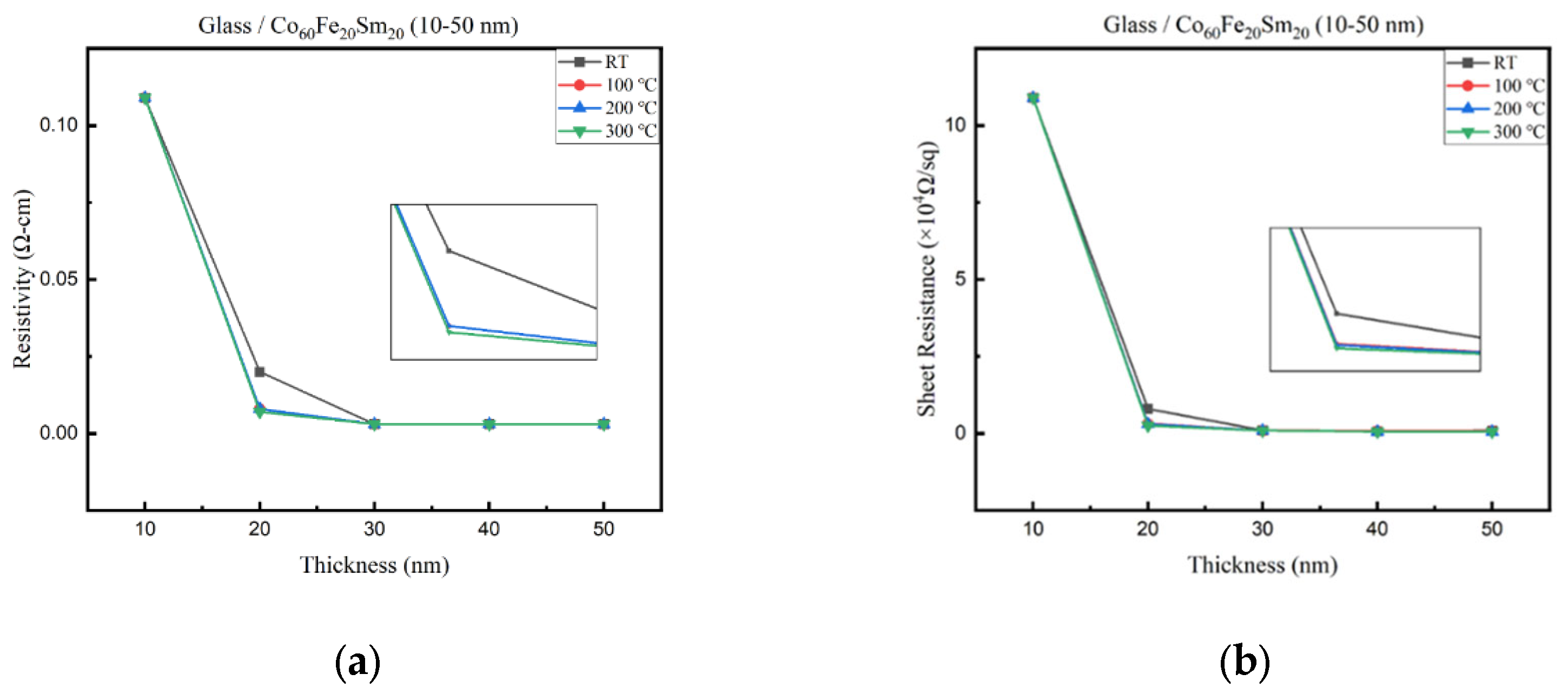
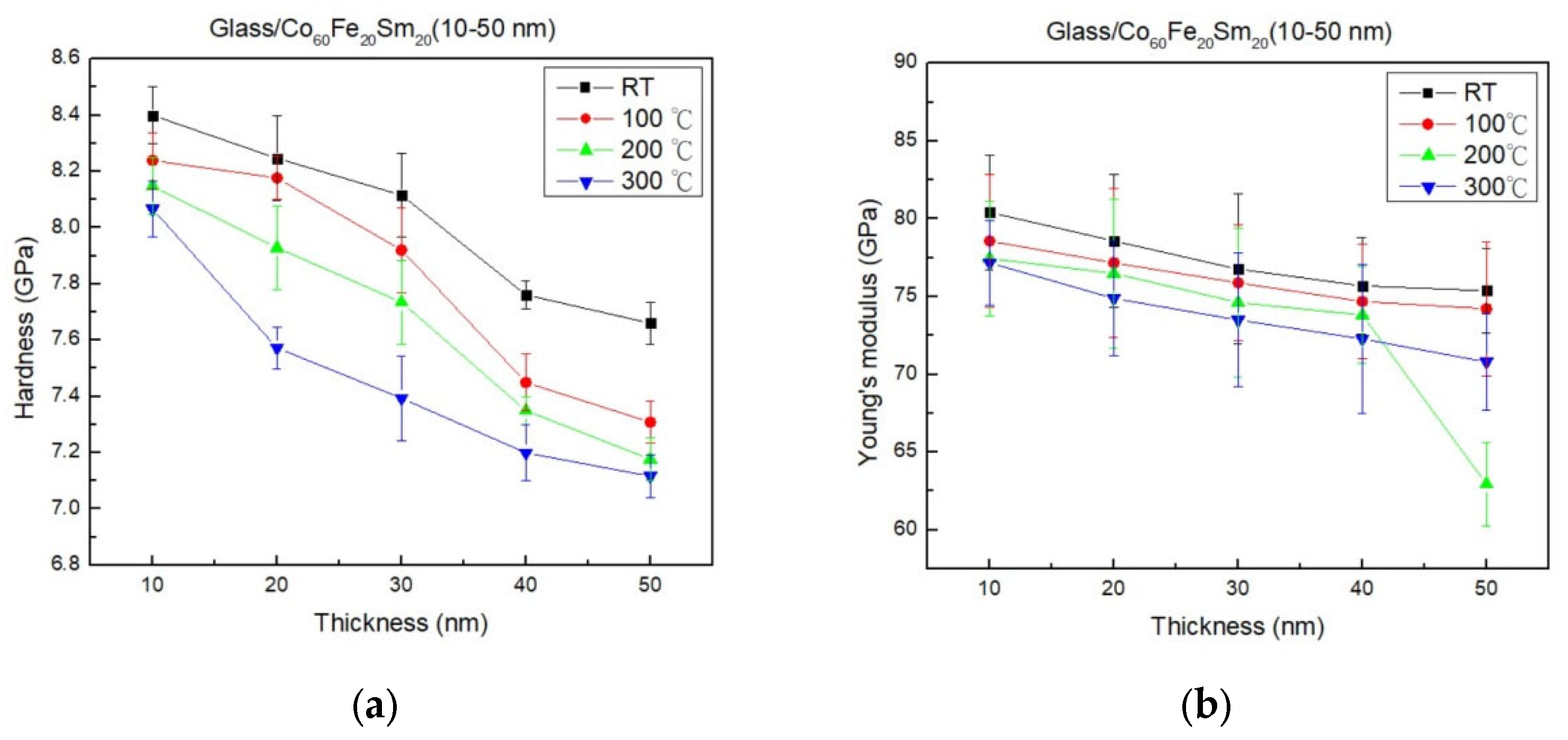
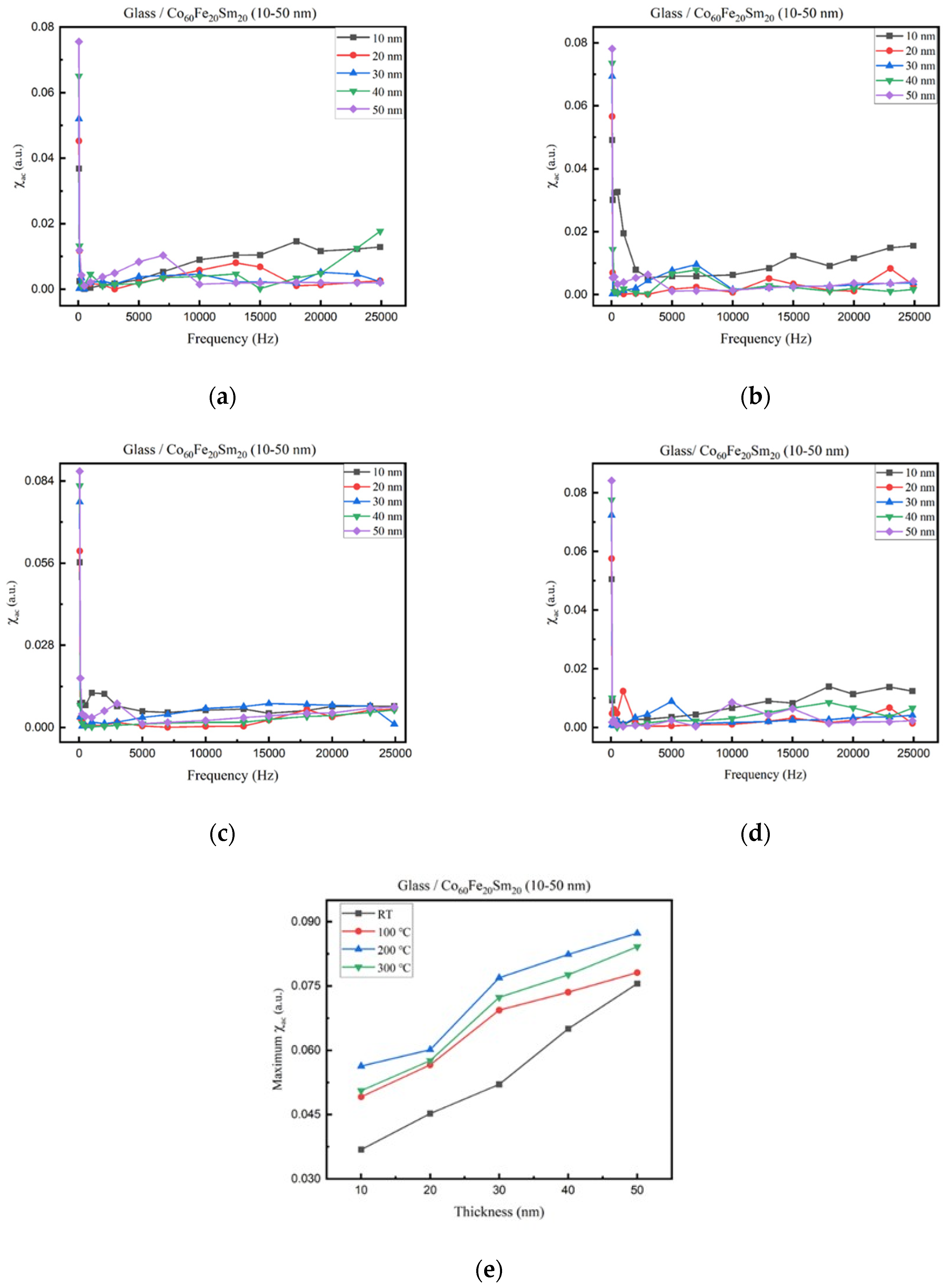
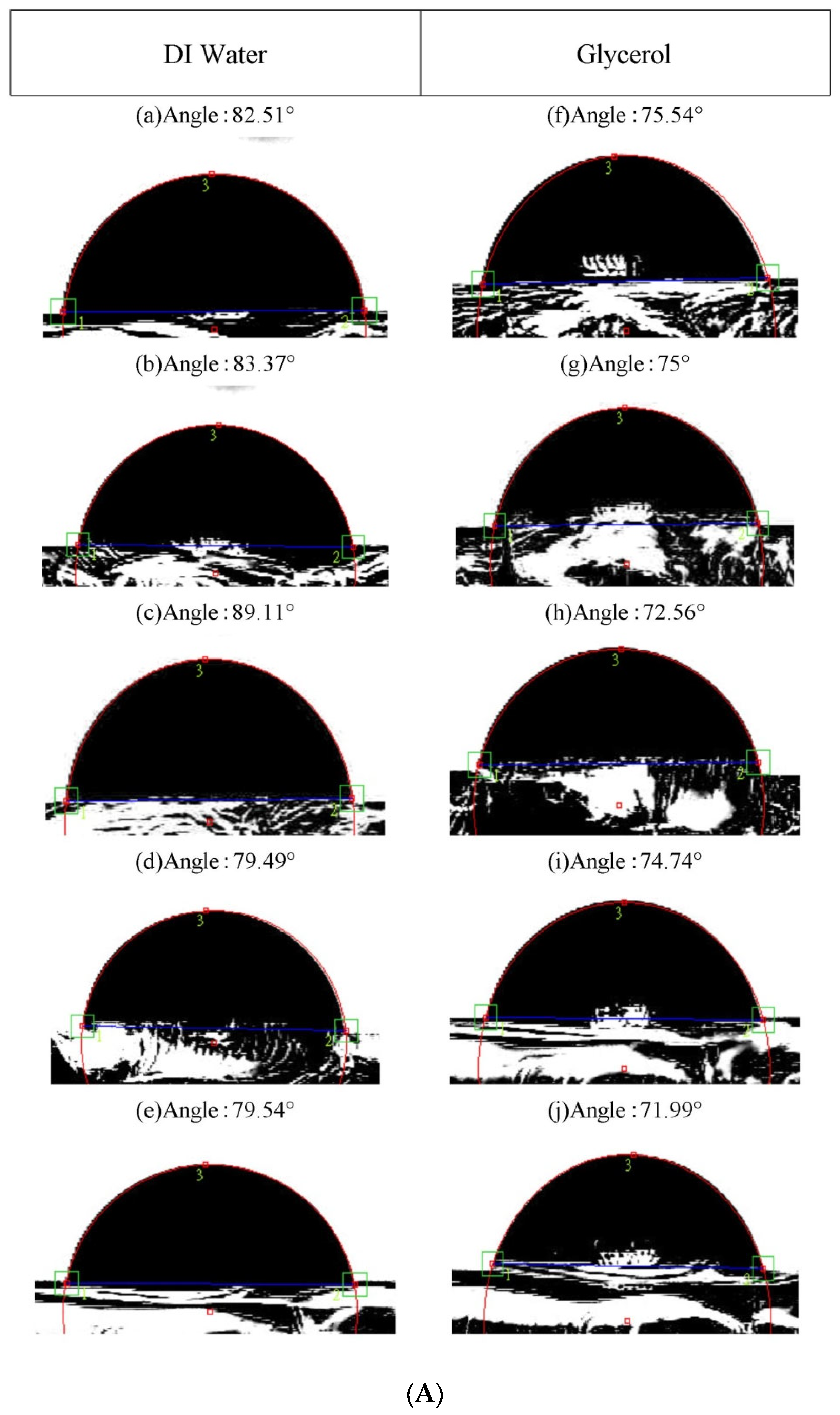
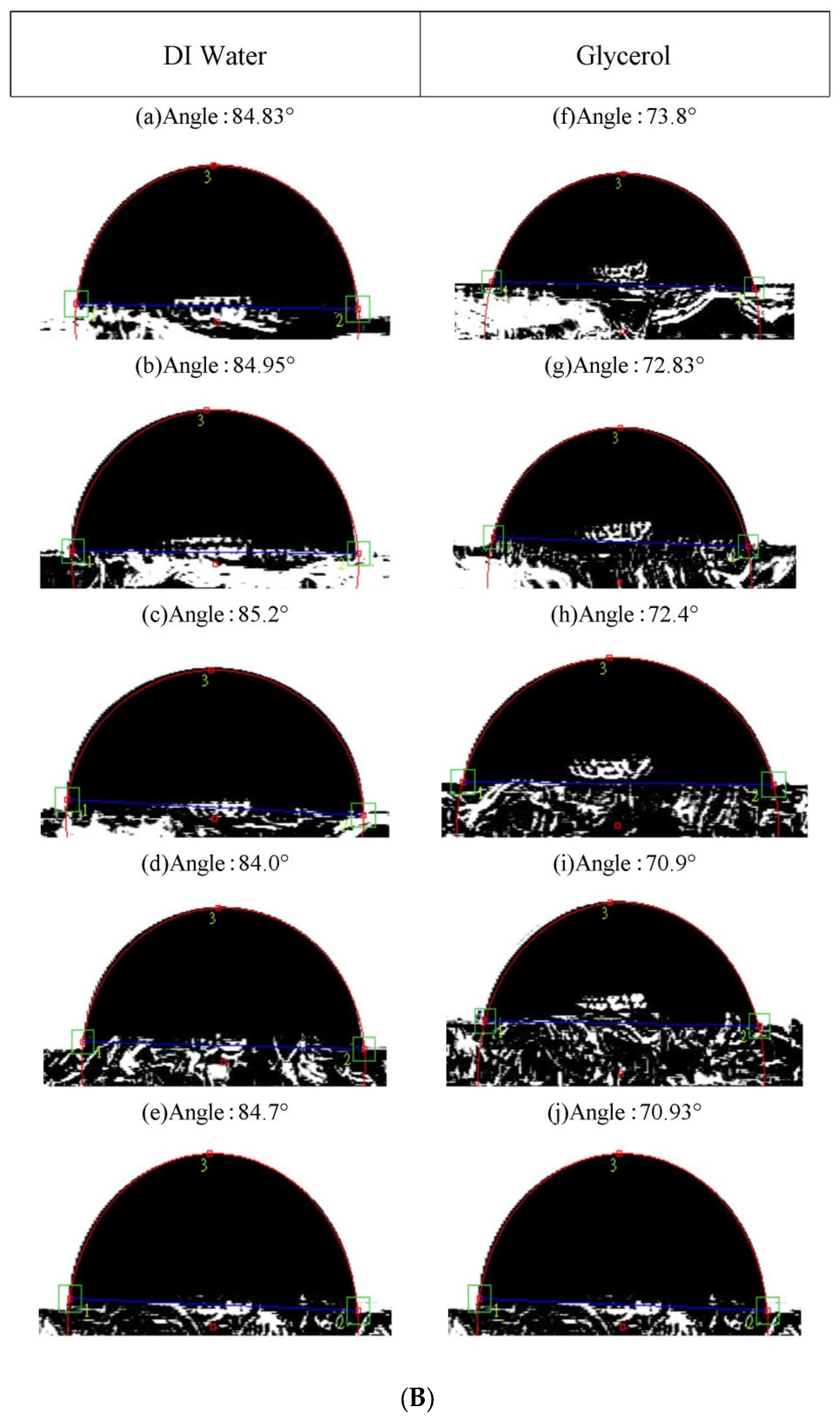
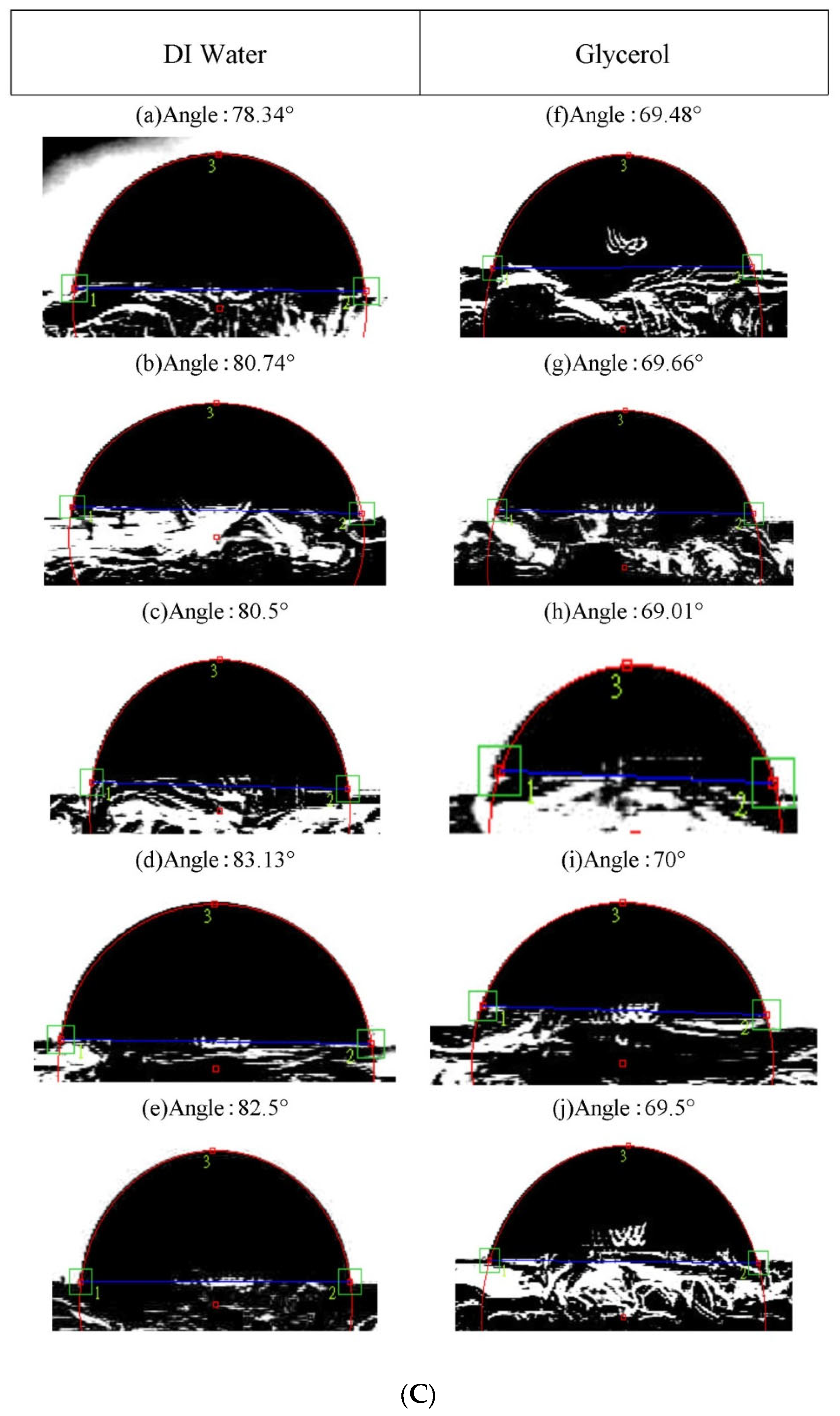
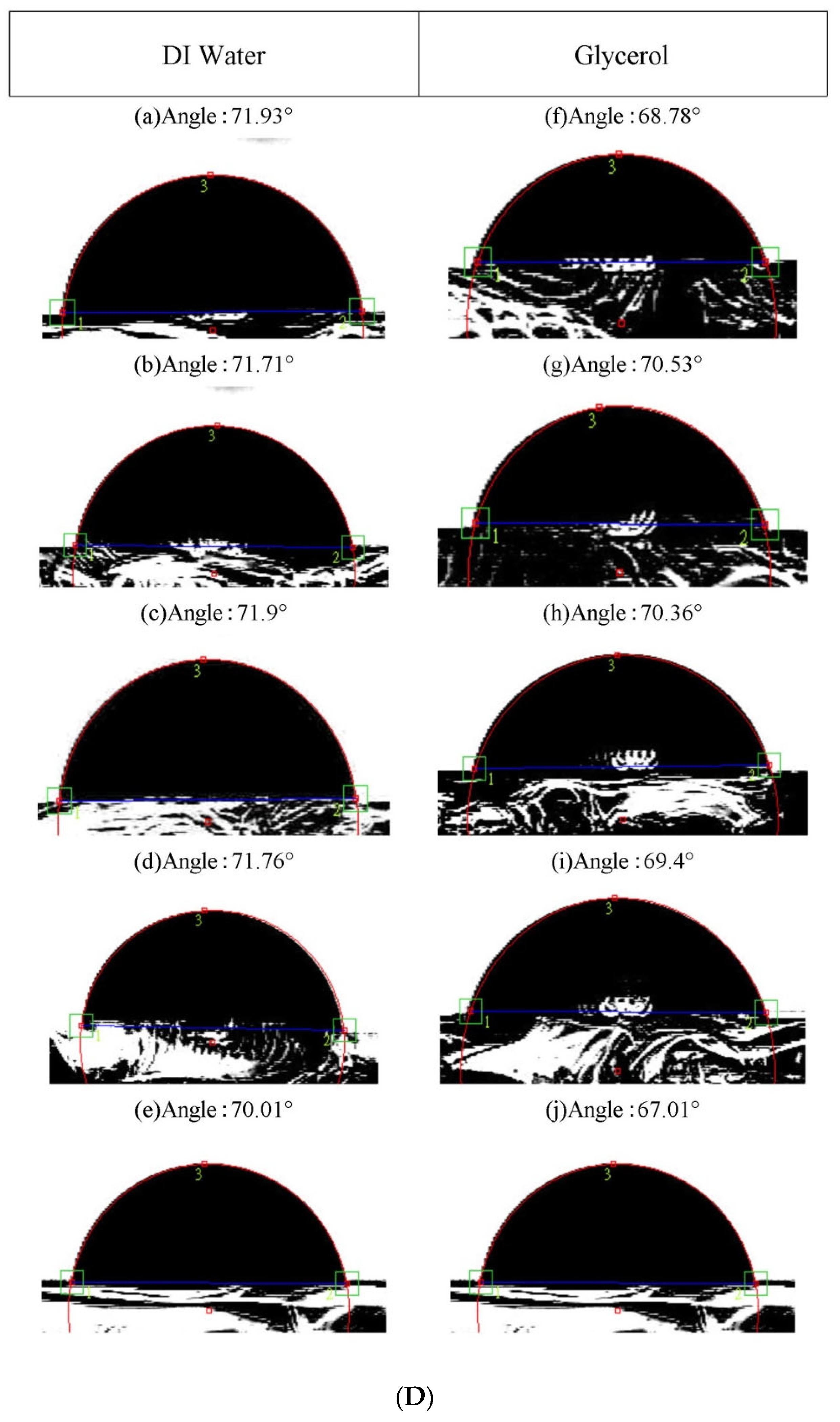
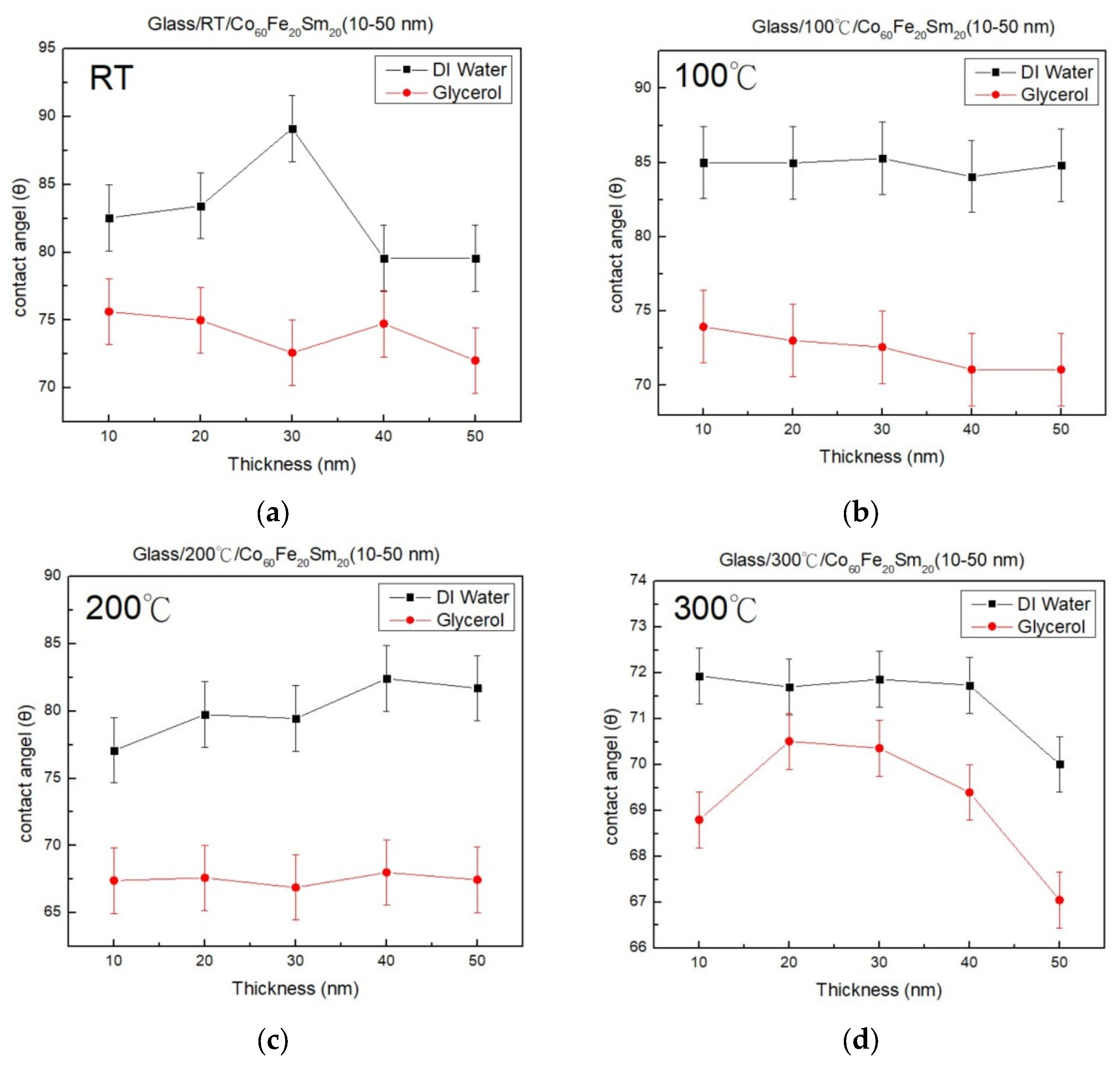
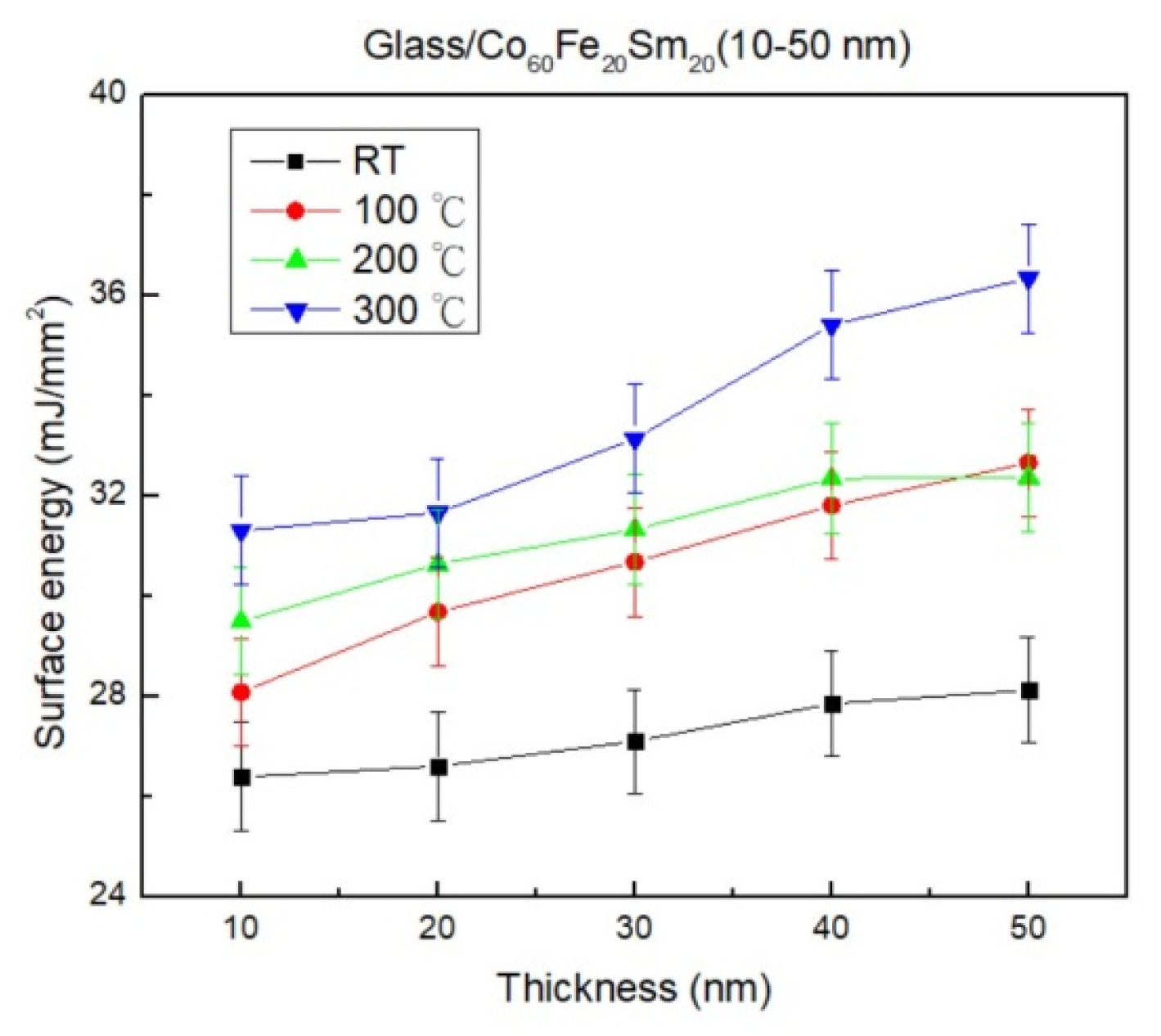

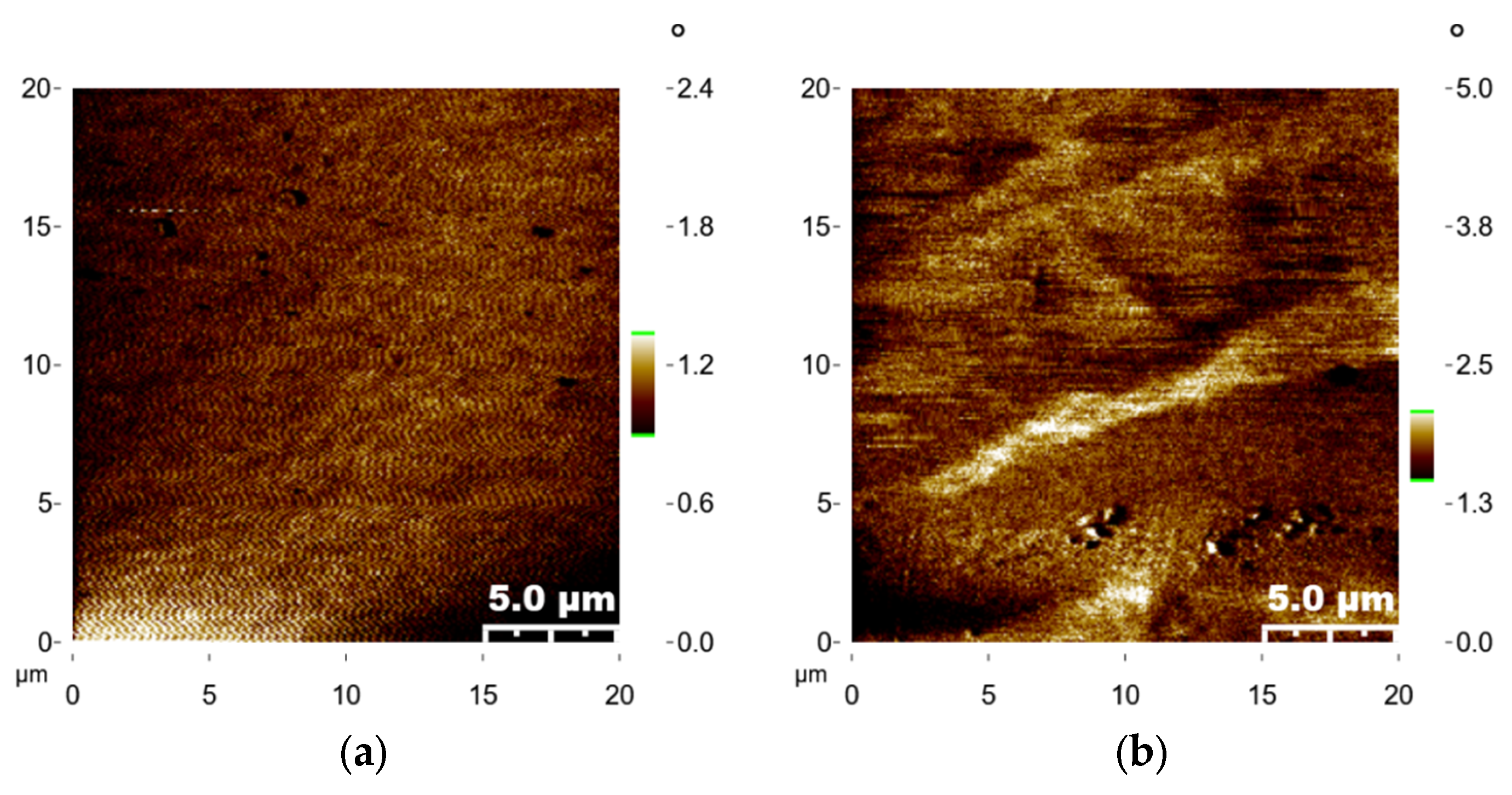
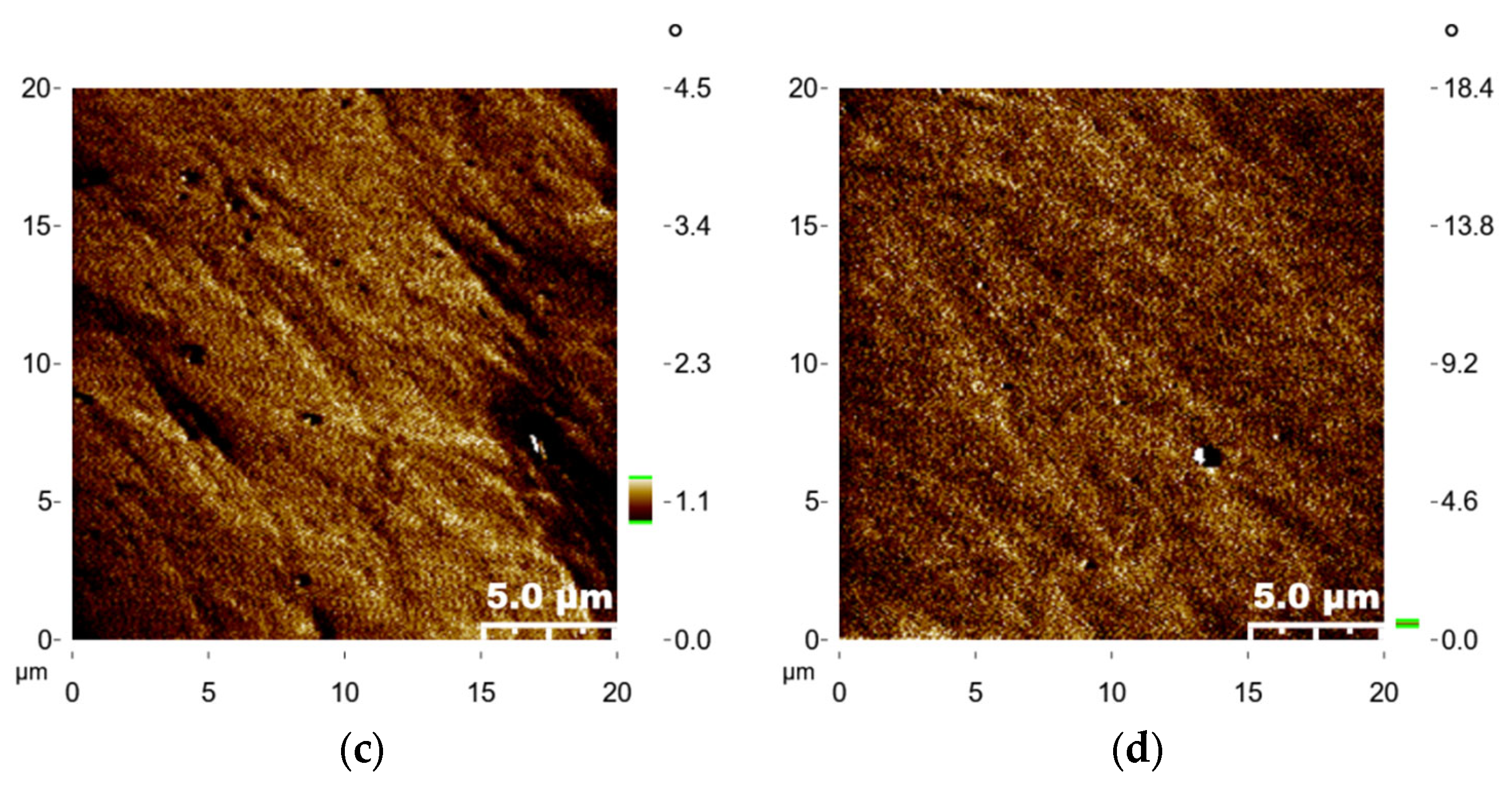
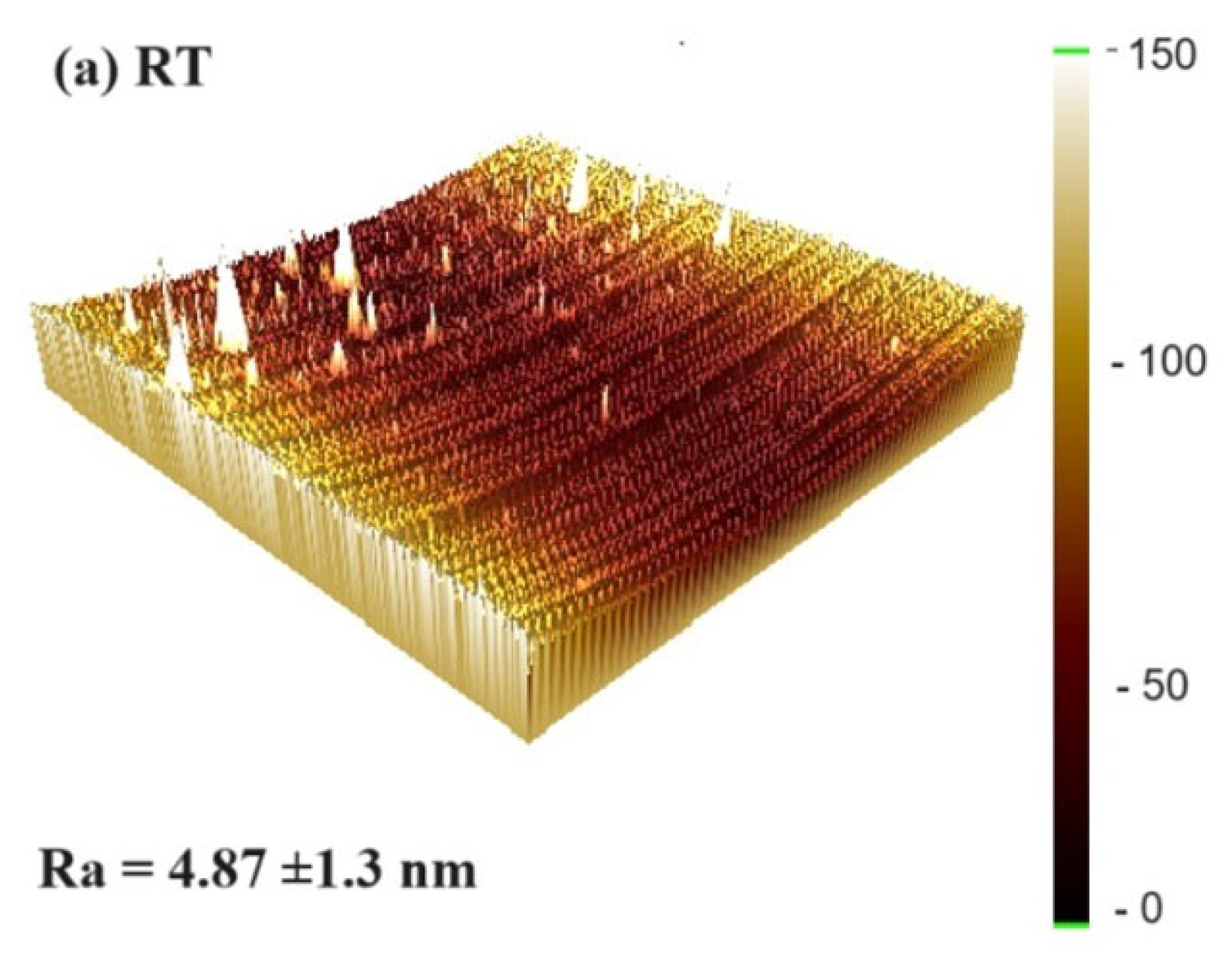
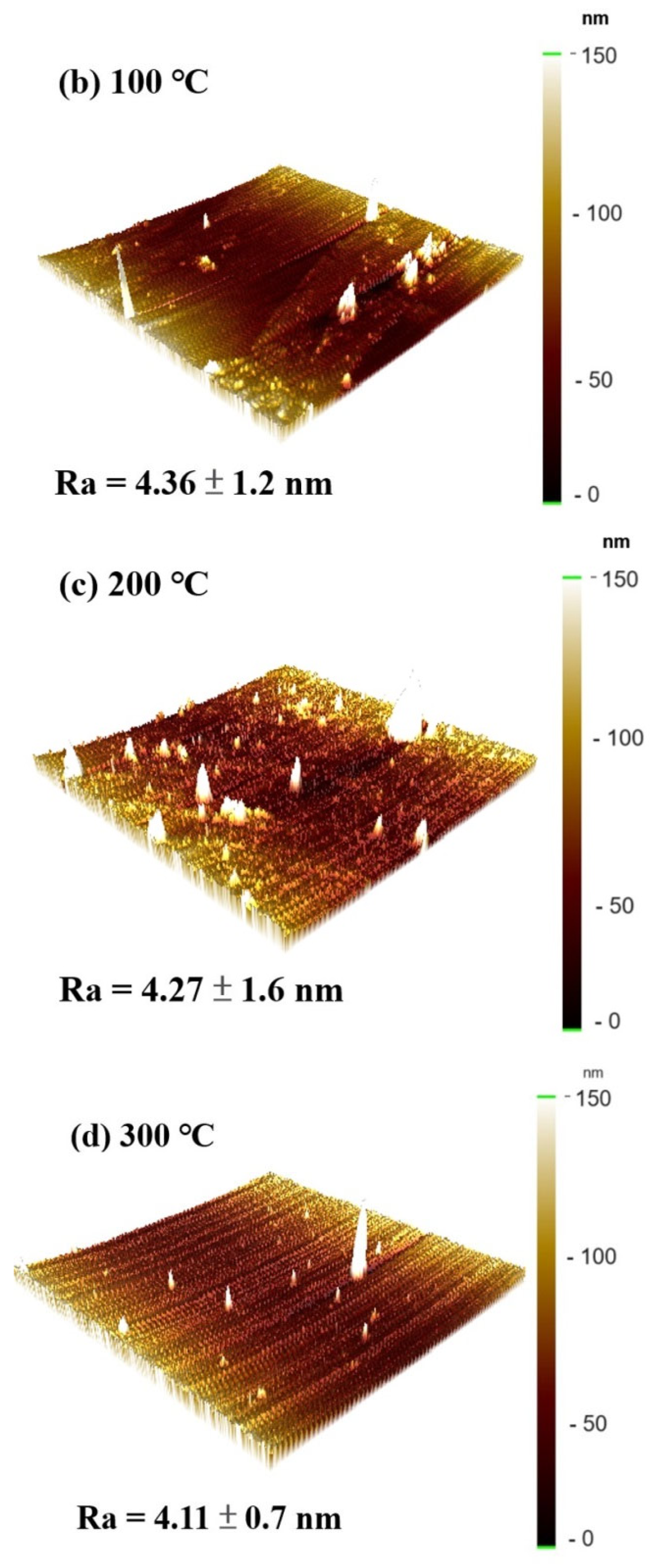
Disclaimer/Publisher’s Note: The statements, opinions and data contained in all publications are solely those of the individual author(s) and contributor(s) and not of MDPI and/or the editor(s). MDPI and/or the editor(s) disclaim responsibility for any injury to people or property resulting from any ideas, methods, instructions or products referred to in the content. |
© 2023 by the authors. Licensee MDPI, Basel, Switzerland. This article is an open access article distributed under the terms and conditions of the Creative Commons Attribution (CC BY) license (https://creativecommons.org/licenses/by/4.0/).
Share and Cite
Fern, C.-L.; Liu, W.-J.; Chang, Y.-H.; Chiang, C.-C.; Chen, Y.-T.; Lu, P.-X.; Su, X.-M.; Lin, S.-H.; Lin, K.-W. Surface Roughness-Induced Changes in Important Physical Features of CoFeSm Thin Films on Glass Substrates during Annealing. Materials 2023, 16, 6989. https://doi.org/10.3390/ma16216989
Fern C-L, Liu W-J, Chang Y-H, Chiang C-C, Chen Y-T, Lu P-X, Su X-M, Lin S-H, Lin K-W. Surface Roughness-Induced Changes in Important Physical Features of CoFeSm Thin Films on Glass Substrates during Annealing. Materials. 2023; 16(21):6989. https://doi.org/10.3390/ma16216989
Chicago/Turabian StyleFern, Chi-Lon, Wen-Jen Liu, Yung-Huang Chang, Chia-Chin Chiang, Yuan-Tsung Chen, Pei-Xin Lu, Xuan-Ming Su, Shih-Hung Lin, and Ko-Wei Lin. 2023. "Surface Roughness-Induced Changes in Important Physical Features of CoFeSm Thin Films on Glass Substrates during Annealing" Materials 16, no. 21: 6989. https://doi.org/10.3390/ma16216989
APA StyleFern, C.-L., Liu, W.-J., Chang, Y.-H., Chiang, C.-C., Chen, Y.-T., Lu, P.-X., Su, X.-M., Lin, S.-H., & Lin, K.-W. (2023). Surface Roughness-Induced Changes in Important Physical Features of CoFeSm Thin Films on Glass Substrates during Annealing. Materials, 16(21), 6989. https://doi.org/10.3390/ma16216989






